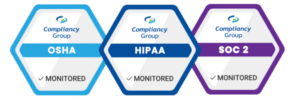
Did you know that at least 42% of companies realize that their human resources integration system (HRIS) implementation failed two years after they attempted it? The reason for this varies for different companies and could be due to an insufficient budget, choosing a solution that lacks scalability, or even a lack of built-in solutions specifically for compliance.
Maintaining compliance is a primary reason that HR in healthcare is so important. Having a department or dedicated professional whose priority is to govern certain procedures and policies keeps an organization’s operations in line with industry regulations.
In other words, human resources (HR) workflows help keep healthcare educated on best practices. If the purpose of your HR department is to keep your practice in line with OHSA guidelines and other related standards, how can you ensure the department’s success if you aren’t using the most efficient methods to run your HR operations?
Instead of playing the guessing game regarding HRIS integration, consider learning more about a solution that prioritizes what your company should focus on and putting what you need in one central location.
Why HRIS Integrations Seems Difficult
A primary reason that HRIS integrations seem difficult from the surface is deciding to go with any solution that sounds appropriate under the assumption that most options will work for every business. Instead, you want to consider what you need, your business struggles, and the features that could provide benefits. Human resources in healthcare aren’t only responsible for onboarding and hiring processes.
These professionals also focus on training, the development of new employees, and many of the logistical processes that keep the practice running properly. Without these particular efforts, healthcare businesses could be more vulnerable to poor training experiences, poor employee engagement and development, and higher chances of noncompliance and process confusion.
To avoid these negative results, compliance officers should focus on the quality of their HRIS solution and integration, the user experience of the solution they choose, and the resources provided with it. These three areas are primary elements that compliance departments lack during HRIS integrations.
Compliance Software Gives You Complete Control
Using compliance software for your HRIS integration gives you complete control over the process and its sustainability after the integration is complete. The right software means HR professionals can control permission and access from anywhere and have more unified access management in a central location.
When you merge HRIS with the right type of compliance software, your organization can efficiently oversee employee access from a singular location, eliminating the need for toggling between multiple systems. This makes the interface and processes much more intuitive and makes it easier to foster transitions into remote work models.
Additionally, HR efforts will see a significant change in the entire user experience, how their training programs run, and the effectiveness of their onboarding and off-boarding processes. There are a variety of other positive segways into successful HRIS implementations that span beyond onboarding tactics as well.
Accessing the Advantages
A lack of managerial support is one reason HRIS systems fail after the initial implementation succeeds. The cause of this is often due to getting lost in robust features that an organization may not need and having a lack of initial training in the system. Instead, compliance officers are looking to simplify HRIS compliance with certain advantages that simplified systems have to offer, such as:
- Scalability
- Self-service options
- Shorter learning curves
- Better data security and compliance workflow support
The benefits of using the right type of compliance software to support your HRIS integration will continue to extend to other key points, such as access to information in real-time and an increase in efficiency.
Removing the Complexity From Healthcare
Regardless of your organization’s size, solutions are built to simplify your HRIS integration with features tailored to your needs. A few key suggestions to help influence a successful product implementation are to evaluate your team’s needs, determine the deadlines you need to hit, and break the project down into phases. Additionally, utilizing an option that streamlines each of these suggestions will help secure project success.
To experience an efficient and hassle-free HRIS compliance experience, allow Compliancy Group to take point on your project.






